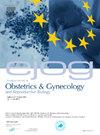实现配送的物流:对家庭诱导随机对照试验的二次分析。
IF 2.1
4区 医学
Q2 OBSTETRICS & GYNECOLOGY
European journal of obstetrics, gynecology, and reproductive biology
Pub Date : 2025-02-01
DOI:10.1016/j.ejogrb.2024.11.043
引用次数: 0
摘要
目的:本二级分析评估实现门诊诱导后阴道分娩的后勤。这包括在宫颈成熟前后Bishop评分的变化,需要额外的成熟剂,从引产到分娩的时间间隔,所有这些都为门诊引产服务提供了宝贵的信息。研究设计:我们随机选择健康的无生育史的妇女,同意在妊娠39周择期诱导分娩,在家中进行三种形式的宫颈初始成熟:12小时的荒废- s, 24小时的荒废- s,或24小时的缓释迪诺前列素(proprocess)。患者在12或24小时后返回医院进行羊膜切开,如果子宫颈仍未成熟,则需要额外剂量的前列腺素。我们提出我们的经验,制定规范的协议门诊引产,以及安全方面的考虑,以协助那些希望采取这种做法。作为二次分析的一部分,评估了每种诱导剂的有效性、分娩时间和住院时间。结果:共有180/271(66%)的产妇在引产后48小时内分娩,254/271(94%)的产妇在72小时内分娩,包括在家的时间。progress组的参与者比an- s组更有可能需要早期再入院(45%对9%)。随机分配到荒废s 12小时和荒废s 24小时的患者更有可能在羊膜切开之前需要额外的前列腺素(65%对34%)。那些不需要额外催熟的人阴道分娩率非常高,从80%到88%不等。诱导剂去除至递送的时间在所有组中相似。从再入院到出院的住院时间中位数为76至88小时。结论:门诊宫颈成熟是应对繁忙产房后勤挑战的有效和有用的选择,大多数产妇在48小时内分娩,包括在家的时间。这种资源友好的选择需要更少的时间在医院设置精心挑选的队列。本文章由计算机程序翻译,如有差异,请以英文原文为准。
Logistics for achieving delivery: A secondary analysis of the home induction randomised controlled trial
Objective
This secondary analysis evaluates the logistics of achieving vaginal delivery following outpatient induction. This includes changes in Bishop score before and after cervical ripening, the need for additional ripening agents, time interval from induction to delivery, all of which provide invaluable information when developing an outpatient induction of labour service.
Study design
We randomised healthy nulliparous women with no significant medical history, who agreed to elective induction of labour at 39 weeks’ gestation, to one of three forms of initial cervical ripening at home: 12 h of Dilapan-S, 24 h of Dilapan-S, or 24 h of slow-release dinoprostone (Propess). Patients returned to the hospital after 12 or 24 h for either amniotomy or, if the cervix remained unripe, additional doses of Prostin. We present our experience with the development of a regulated protocol for outpatient induction of labour, as well as safety considerations, in order to assist those wishing to adopt such practice. Effectiveness of each induction agent, time to delivery, and length of hospital stay were assessed as part of this secondary analysis.
Results
A total of 180/271 (66%) of all nulliparous women were delivered within 48 h of induction commencing, and 254/271 (94%) delivered within 72 h, inclusive of the time period spent at home. Participants in the Propess group were more likely to require early readmission than in the Dilapan-S groups (45% vs 9%). Patients randomised to Dilapan-S 12 h and Dilapan-S 24 h were more likely to require additional Prostin prior to amniotomy being possible (65% vs 34%). Those who did not require additional ripening had very high vaginal delivery rates ranging from 80% to 88%. Induction agent removal time to delivery was similar across all groups. The length of hospital stay ranged from a median of 76 to 88 h from readmission to discharge.
Conclusion
Outpatient cervical ripening is an efficient and useful option for dealing with the logistical challenges facing busy Labour Wards, with the majority of nulliparous patients delivering within 48 h, including time spent at home. This resource-friendly option requires less time within the hospital setting for a carefully selected cohort.
求助全文
通过发布文献求助,成功后即可免费获取论文全文。
去求助
来源期刊
CiteScore
4.60
自引率
3.80%
发文量
898
审稿时长
8.3 weeks
期刊介绍:
The European Journal of Obstetrics & Gynecology and Reproductive Biology is the leading general clinical journal covering the continent. It publishes peer reviewed original research articles, as well as a wide range of news, book reviews, biographical, historical and educational articles and a lively correspondence section. Fields covered include obstetrics, prenatal diagnosis, maternal-fetal medicine, perinatology, general gynecology, gynecologic oncology, uro-gynecology, reproductive medicine, infertility, reproductive endocrinology, sexual medicine and reproductive ethics. The European Journal of Obstetrics & Gynecology and Reproductive Biology provides a forum for scientific and clinical professional communication in obstetrics and gynecology throughout Europe and the world.

 求助内容:
求助内容: 应助结果提醒方式:
应助结果提醒方式:


